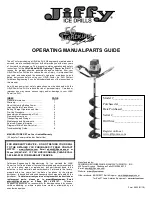
Maintenance
37
on a regular basis. When the debris is one to two
inches deep, complete the following procedure (refer
to Figure 41 throughout this procedure):
m–4773
4
1
2
1
3
5
Figure 41
1.
Side weights
2.
Rear panel
3.
Fuel tank bracket
4.
Fuel tank
5.
Chassis
1.
Lift and support the front of the traction unit.
2.
Stop the engine and remove the key.
3.
Disconnect the negative battery cable.
4.
Remove the bolts, washers, and lock washers
securing the two side weights, removing the
weights (Fig. 41).
5.
Open the rear access cover; refer to Opening the
Rear Access Cover, page 23.
6.
Remove the three carriage bolts and washers
from the battery base and the fuel tank bracket,
removing the bracket (Fig. 41).
7.
Remove the six nuts and bolts securing the rear
panel, removing the panel (Fig. 41).
8.
Loosen the tank cap to relieve pressure.
9.
Place a clamp on the fuel line, two inches from
where it comes out of the fuel tank.
10. Slide the fuel tank to the rear (Fig. 41).
11. Disconnect the fuel line.
12. Disconnect the two wires leading to the right
side of the tank (Fig. 42).
m–4776
1
2
Figure 42
1.
Black wire
2.
Orange wire
13. Carefully remove the tank and set it upright to
keep from spilling the gasoline.
POTENTIAL HAZARD
•
In certain conditions gasoline is extremely
flammable and highly explosive.
WHAT CAN HAPPEN
•
A fire or explosion from gasoline can burn
you, others, and cause property damage.
HOW TO AVOID THE HAZARD
•
Remove the fuel tank outdoors in an open
area. Wipe up any gasoline that spills.
•
Do not remove the fuel tank near an open
flame or where gasoline fumes may be
ignited by a spark.
•
Do not smoke while handling fuel tank.
14. Remove any large deposits of debris.
15. Wash out the chassis with water until the water
running out the back of the unit is clear.
IMPORTANT: Take care not to get water into
the engine or electrical components.
16. Slide the fuel tank part way into the chassis
(Fig. 41).
Содержание Dingo TX 22306
Страница 7: ...Safety 5 Slope Chart...






































